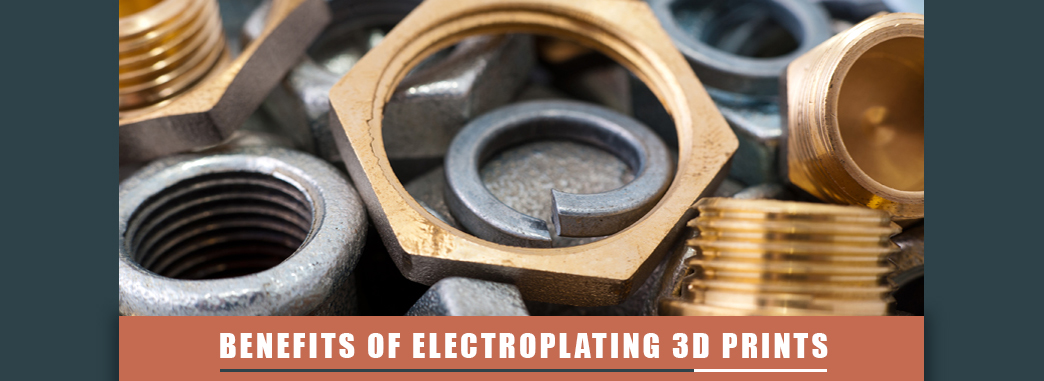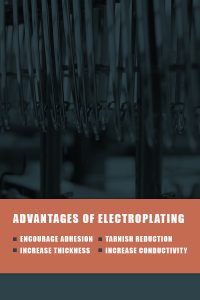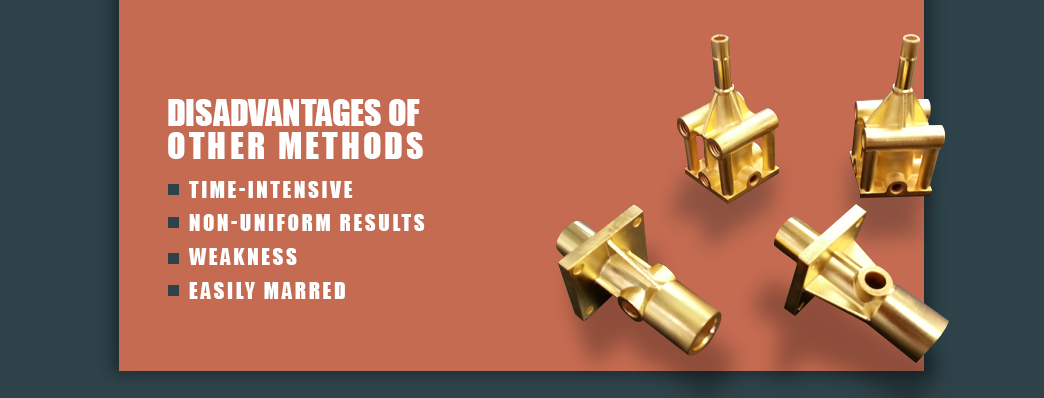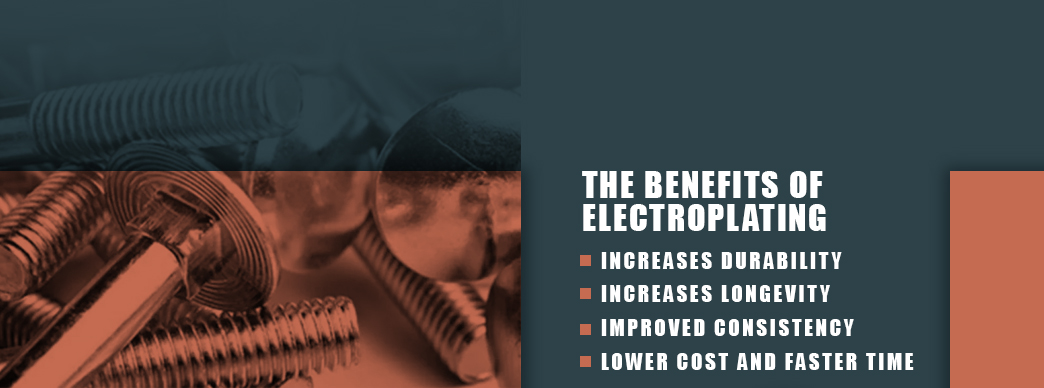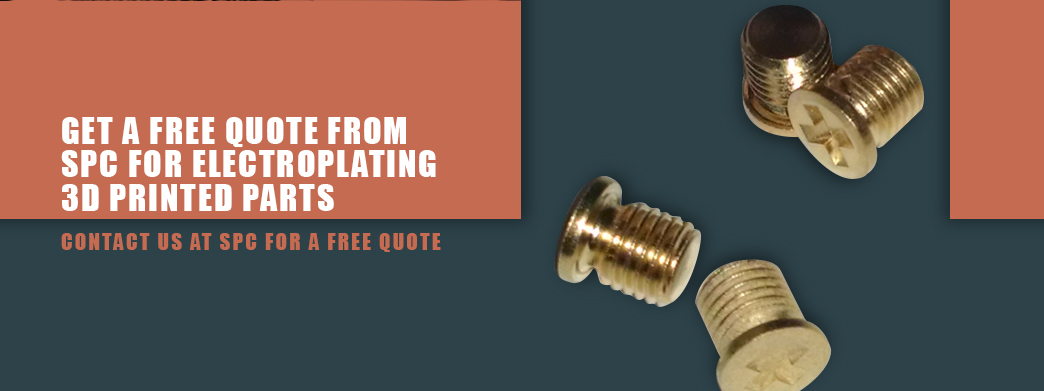Quickly creating parts from a design has made 3D printing a newly popular option in the manufacturing world, especially printing with metals and plastics. Electroplating printed pieces enhances their durability and protects them from wear. The metal finishing could also make the parts more suitable for specific tasks.
Quick Links
Advantages of Electroplating | Disadvantages of Other Methods?
The Benefits of Electroplating | Get a Free Quote From SPC for Electroplating 3D Printed Parts?
Advantages of Electroplating
Electroplating transfers metal atoms from one metal to another when they are in a solution and have electricity pass through them. When you choose this method for coating 3D printed objects, you will enjoy multiple advantages compared to other means of finishing the project.
Because most 3D printers use plastic or resins, electroplating becomes slightly more difficult though much more beneficial. With plastic, the material can easily sustain damage from typical use. However, when you coat the item with metal, it becomes more durable.
Metal finishing of 3D prints makes the parts more durable and conductive to heat and electricity. You have multiple metals to choose from for your finishing. With surface materials that include copper, gold, nickel and silver, metal finishing can transform your printed project into something that offers the benefits of a metal exterior with the light weight of the printed material inside.
Some common reasons for electroplating items include increasing durability and improving conductivity. Other reasons to choose to electroplate include these ways of enhancing the item:
1. Encourage Adhesion
Electroplating works best with a base layer of metal. Using electroless plating to deposit copper onto a plastic 3D printed object ensures other metal layers added through electroplating adhere to the piece better.
2. Increase Thickness
Occasionally, printed items will need extra thickness for durability. If you want to electroplate with palladium to increase the thickness and appearance, plan for the added depth by adjusting the printed model’s dimensions.
3. Tarnish Reduction
Some printed materials may need extra protection against scratching and tarnishing. Reusable printed utensils will need the added durability of a metal coating to prevent scratches and tarnish from using the items in a variety of temperatures and chemical compositions. Without treatment, the acids in food, teeth scraping on the utensil or the extreme heat and cold of cooking could mar the surface.
4. Increase Conductivity
You can print electronic components with a 3D printer and coat the surface with silver to make the part conductive. Doing so lowers the overall cost and time to create the piece while still giving you the benefits of a component that transmits electricity. Scientists have already acknowledged this cost-saving means of creating conductive components through selectively electroplating specific surfaces.
Disadvantages of Other Methods
Other means of finishing printed projects do not give you the consistency you’ll achieve from using plating. In fact, various methods of finishing other than electroplating have multiple disadvantages you should consider before deciding on the finish you want.
1. Time-Intensive
Finishing 3D printed parts with paint is only one way to get the style you want. Unfortunately, for the painted surface to adhere well, look good and be durable, you need to apply several layers to the part. First, you need a primer. This paint type creates a smooth, even surface onto which the upper paint layer can hold. Primers have neutral colors to keep from detracting from the paint. Secondly, after the primer dries, you need to add the undercoat, which locks the primer’s pale shade from the paint. After the undercoat dries, now, you can paint the part. Lastly, you can put the clear coat on top, which protects the color beneath from chipping.
The multiple layers needed to paint a printed part need several types of paint as well as ample time and space for allowing the item to dry. Unless you have the luxury of time, electroplating has the edge here for finishing a printed part.
2. Non-Uniform Results
The results you get with painting depends highly on the skill of the artist doing the painting as well as how carefully he prepared the surface. While one part may look good, all painted parts won’t look the same. Uniformity falls by the wayside with something that coats as unevenly as paint. Electroplating removes the human element during the plating process, producing smoother, more uniform results.
3. Weakness
Even if you apply a clear coat on top of a painted object, it still will not be as durable as the same item with a metal finish. Metals offer long-lasting durability. An electroplated metal surface will not flake off as paint could. Quality electroplating comes with a variety of tests to ensure adhesion.
Metal on the outside also strengthens the structure, making it less susceptible to breaking, depending on the metal used. A surface coloring with paint cannot add strength as metals can. When strength matters, choose plating rather than painting for your printed projects.
4. Easily Marred
A surface coating of paint, or even multiple layers of paint, can easily get scratched or flake off. With plating, the metal coating adheres tightly on a chemical level to the base. Paint only covers the surface with a layer of color. With a metal surface, printed objects have a more robust exterior. Designers often use electroplating to improve the hardness of an object, which is especially important for the items created with softer plastics or resins. Increasing the hardness extends the life of the part while reducing the likelihood it will sustain damage from regular use.
The Benefits of Electroplating
Electroplating can give your project an edge. The metallic exterior offers multiple benefits, some of which you may find more necessary for your project than others. Without electroplating, though, you won’t get the extra durability, longevity, consistency, speed and lower costs of this finishing method.
1. Increases Durability
Metal finishing increases the durability of a project. Without plating, a plastic printed item can bend or break. With electroplating, the rigidity of the device could increase up to ten times compared to an unfinished part. The more durable parts have a higher number of uses than their weaker, not-finished counterparts.
To ensure durability, we test electroplated parts to check for the integrity of the plating. Our tests include these rigorous assessments of our plating results:
- Impact test: The coating must adhere even after one of our workers strikes the object with a hammer.
- File test: We file off a part of the finished piece to look at the border where the metal meets the substrate. If we can pull the metal off or notice any peeling, we need to redo the electroplating process.
- Peel test: Peeling should not happen with proper finishing. To evaluate the finish with this test, we solder a steel strip to the piece and attempt to pull off the steel. If the electroplating material comes off with the strip, the finishing process did not succeed.
- Chisel test: Using a chisel, we try to cut through the metal. Successfully cutting through the finish means the plating failed.
- Burnishing test: During the burnishing test, we try to rub the coating off with a smooth tool. A quality plating job does not come off even with 15 seconds of burnishing.
- Heat test: The heat test evaluates the finish’s adherence in extreme heat and cold and sudden changes between the two. We heat the piece then immediately plunge it into a cooling liquid to chill it. We look for the metal to remain firmly attached to the base without cracking or other signs of stress from the sudden temperature change.
- Bend test: With the bend test, we bend the part through 180-degrees and examine the coating for signs of flaking. Even when subjected to these forces, the metal surface needs to stay intact without exhibiting signs of breaking or wear.
- Grid test: We use a grid test to see how well the finish holds to the base when we score a grid pattern into the surface. If the areas between the cuts lift from the substrate, the finishing did not adhere well. Even with multiple scores, the metal must hold fast to the bottom layer to get our approval.
These durability tests for our coatings also ensure the entire part holds up to rigorous use. If the electroplated layer holds tightly to the surface, the whole piece gains more durability.
2. Increases Longevity
More durable parts last longer. The ability to withstand impacts is not the only way longevity increases. Metal finishing on 3D prints adds a surface barrier to keep the environment from causing damage to the piece. The metal seals plastics, helping them to resist water and dirt damage. Additionally, choosing a corrosion-resistant material for the surface reduces rust and wear.
Wear may also occur when parts rub against each other, generating friction. Nickel helps reduce friction between parts. Other metals offer different attributes that help increase longevity. Gold can increase heat resistance while silver makes the part more conductive.
When deciding whether to choose electroplating or another finishing technique for printed parts, remember that metal finishing will extend the life of the component. For finished components installed in hard-to-reach places, a long-lasting design will save time and money in future maintenance.
3. Improved Consistency
Consistency with parts is essential to all industries, but some sectors have lower tolerances of production defects than others. One example of the need for consistency is in scientific equipment. Scientists at the Swiss Ecole polytechnique federale de Lausanne (EPFL) used metal-finished 3D parts to create beam splitters. They chose to combine electroplating with 3D printing due to its speed and consistency. The finished results have no surface defects such as abrasions, scratches or pits that could otherwise mar the experiment.
The finishing process for painting may not produce a perfectly even coating the way metal finishing will. Painting can create areas with more paint, adding unnecessary thickness to the piece. This surface unevenness can happen with spray paint by holding the can over one part of the printed piece slightly too long.
Consistency also comes from the digital process used to print and finish products with electroplating. The entirely digital process makes it simple for a worker to print and finish a replacement part with the exact dimensions of any other pieces using the same plans. If a team of scientists can rely on such consistency for their experiments that need parts to have the same properties, any industry can benefit from this standardization.
4. Lower Cost and Faster Time
With tight bottom lines, reducing costs in any way is always beneficial. With 3D printing, plating the objects after the printing lowers the total costs without sacrificing the exterior’s metal attributes. NASA aerospace engineer Kevin Reynolds outlines the FrankenEye project that uses printed parts and electroplating to revive old aircraft to turn them into unmanned air systems. He touts the benefits of printing and metal finishing as a means of lowering the cost and the project creation time. With printed parts made of plastics and plated, the weight of the plane parts is lower than if the construction had used solid metal parts. Lowering the weight of the aircraft reduces the need for additional fuel. Additive processes, which includes electroplating and 3D printing, help reduce overall project costs while still helping to reduce fuel use in the final plane.
NASA aircraft are just one instance of pairing printing and plating for reducing project costs and turnaround time. If you need the benefits of metal, you may think about printing with a 3D printer that creates solid metal objects, but using these printers can be expensive. Printers that use plastic cost less to run, producing lower-cost results. Metal finishing on the outside of the printed object will provide the appearance and qualities of a metal item without the weight or cost.
Faster production time reduces waiting and moves operations forward. When the EPFL decided to use electroplated 3D printed shapes to create beam splitters, the scientists got reliably designed parts in addition to increasing the production speed by 50 to 100 times. Compared to traditional methods, which could require months of processing, printing and metal finishing got the parts done in 48 hours. Getting the parts faster meant less time lost before the researchers could begin their work. Using this method to create specialized pieces for research could transform scientific experimentation in the future.
Get a Free Quote From SPC for Electroplating 3D Printed Parts
The process of 3D printing and finishing with electroplating can give you the parts you need with better durability and longevity. Thanks to the structure of both printing and finished processes, you will get more consistent parts in less time compared to other manufacturing methods. If NASA and scientific researchers can trust electroplating on printed parts for their projects, you can do the same.
If you want to get started on cheaper products made faster, contact us at SPC for a free quote. We offer professional consultation, so you get the results you need.


